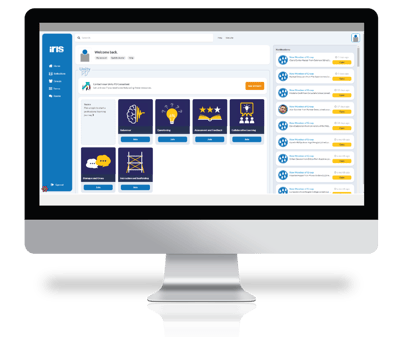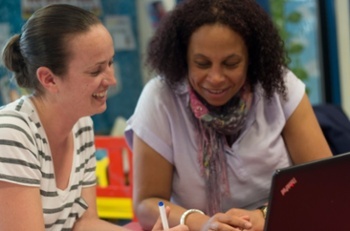 Coaching in education is more than just questioning. It is a powerful approach to supporting and developing effective teaching practices. Through coaching, teachers receive personalised support, feedback, and guidance that can enhance their professional development and improve student outcomes.
Coaching in education is more than just questioning. It is a powerful approach to supporting and developing effective teaching practices. Through coaching, teachers receive personalised support, feedback, and guidance that can enhance their professional development and improve student outcomes.
Coaching provides teachers with opportunities to reflect on their teaching practices, identify areas for improvement, and develop new skills and strategies to enhance their teaching effectiveness.
We have spoken to a number of experienced teachers about the best tools focused on increasing the effectiveness of coaching in schools, and have compiled a list of the 11 best.
11 tools you can use to make the most of coaching sessions
1. Rapport building
In the face of increasing workloads and time pressures, rapport building can be mistaken for idle chit chat. But if we want coaching conversations to be meaningful and lead to real change, building strong relationships is essential. Connecting with colleagues goes beyond a quick “How was your break?”—it involves showing genuine curiosity and creating space for authentic dialogue.
Rather than accepting surface-level responses, consider expanding on simple questions to spark deeper conversations. For example:
Coach: What did you do over the holidays?
Teacher: Not much, just a trip to the theatre.
Coach: Oh nice! What did you see? Were you with family?
These small but intentional moments of connection help create trust, openness, and psychological safety—the foundation of any effective coaching relationship.
2. Modeling
Modeling is a coaching technique that involves demonstrating a new skill or technique for the teacher to observe and then attempt to replicate. Coaches can demonstrate the new skill or technique through the use of video which has many benefits:
Flexibility
Teachers can revisit the demonstration as often as needed, which is especially useful for complex techniques that require deeper understanding over time.
Repeatability
Video allows the teacher to watch the demonstration as many times as they need to fully understand the skill or technique being demonstrated. This is particularly helpful for more complex skills or techniques that may require multiple viewings for the teacher to fully grasp.
Focus
Modeling via video allows the coach and teacher to focus on specific aspects of the demonstration, such as body language, tone of voice, or pacing. This can be particularly helpful in situations where the coach wants to highlight specific elements of the skill or technique being demonstrated.
Objectivity
Having a recorded model removes the limitations of memory or bias. Teachers and coaches can review with fresh eyes, even adopting the perspective of a student to assess how the approach feels from the learner’s point of view.
3. Observation
Observing teachers is a powerful coaching tool that provides invaluable insight into classroom practice. By observing a lesson, coaches gain a firsthand understanding of what’s working well and where further support may be needed. For teachers, it’s an opportunity to reflect on their strengths, identify areas for growth, and set meaningful goals to improve their practice.
When combined with video technology, observation becomes even more impactful. Video allows teachers to revisit lessons, reflect more objectively, and share clips for focused feedback and collaborative discussion. It also removes the pressure of live observation, giving a truer picture of everyday teaching.
Adding AI-powered tools takes this one step further—providing data-driven insights, identifying patterns in teaching behaviours, and helping coaches and teachers make informed decisions about where to focus their efforts. Together, video and AI unlock a more accurate, scalable, and empowering approach to instructional coaching.
Our Lesson Observation blog focuses on ways to support great teaching using lesson observation.
4. Scaling
Scaling encapsulates the idea of change and progress very easily. By pinpointing a position on a numerical scale, our attitude or feelings towards the most complex, messy situation can be quantified and steps forward can be made. If necessary, simply sketch out a scale. For example:
Coach: On a scale of 1-10, how happy are you with boys’ engagement in this class at the moment?
Teacher: It is about a 3.
Coach: What is happening in a class where it is 8?
5. Reflection
Reflection can be a powerful coaching tool for teachers because it allows them to develop a deeper understanding of their teaching and learning practices, identify areas for improvement, and develop an action plan for meaningful change. When done well, reflection supports sustained professional growth, boosts classroom effectiveness, and ultimately enhances student learning outcomes.
Traditionally, reflection has relied on memory or anecdotal evidence. But technology is transforming the process—making it more accurate, efficient, and impactful. By using tools like video and AI, teachers can move beyond guesswork and gain objective insights into their practice. Video enables teachers to see their teaching as it actually happens—not just how they or another remembers it. This creates powerful opportunities for self-awareness, allowing teachers to spot subtle classroom dynamics, assess the impact of their instruction, and observe how students respond in real time. AI insights take this a step further. AI can help surface patterns that may not be immediately visible—such as teacher talk-time ratios, questioning techniques, or student engagement trends. These insights provide teachers with targeted, data-informed feedback, helping them reflect with greater precision and track progress over time.
Combining reflection with video and AI not only strengthens coaching conversations but also empowers teachers to take ownership of their development. It makes professional learning more personalised, actionable, and efficient—so teachers can spend less time guessing what’s working, and more time improving what matters.
Want to know how to encourage reflective teaching in your school? View the Ultimate Guide to Reflective Practice in Teaching.
6. Minute by minute contracting
Initial coaching training in education emphasises that coaching is not about providing solutions. As a result, we can be nervous about sharing our expertise, but our expertise could be helpful for the coachee. Minute by minute contracting involves seeking permission from the coachee for you to offer your own experience or knowledge. For example:
Coach: Would it be helpful if I shared what I did with a similar group of boys last year?
Teacher: Yes, that would be great actually. I’m not sure where to start.
Coach: Well, it took a while, but I found the start of lessons was key—so I changed my starters. I made them shorter and more competitive.
This approach helps maintain trust and autonomy, while still allowing the coach to bring valuable experience into the conversation in a respectful, purposeful way.
7. Questioning
Questioning helps coachees develop their critical thinking skills, improve their understanding of a topic, and clarify their thought processes. Through questioning, a coach can guide teachers to reflect on their teaching practices, identify areas for improvement, and develop a deeper understanding of the content being taught. Coaches can use a variety of questioning techniques that can help teachers think reflectively about their practice. For example:
Open-Ended Questions
Open-ended questions encourage deeper reflection and exploration. Beginning with “what,” “how,” or “if” avoids yes/no responses and invites the teacher to think more broadly.
Example: “What do you notice about how the students responded to that activity?”
Probing Questions
These dig beneath the surface to prompt greater insight and clarity.
Example: “Why do you think that worked so well?” or “What might be the impact if you continued with that approach?”
Hypothetical Questions
Hypothetical questions are a great tool for getting teachers to consider alternative approaches to their teaching practice.
For example, 'If this behaviour continued in the lesson, how would you change your strategy?'.
Consider using tools that incorporate AI offering data-driven insights into classroom questioning interactions. For example, AI can identify how many open vs. closed questions were asked, highlight missed opportunities for deeper questioning, or surface patterns in dialogue that may impact reflection and engagement. This kind of analysis helps coaches refine their questioning techniques and supports teachers in becoming more aware of their own classroom questioning styles—ultimately leading to more thoughtful, responsive teaching.
8. Silence
In the classroom, we’re taught the value of wait time—giving students space to think before responding. The same principle applies in coaching. Silence isn’t awkward; it’s a powerful tool.
Allowing moments of quiet during coaching conversations gives teachers the space to process, reflect, and arrive at deeper insights. It may feel counterintuitive in a profession so defined by constant communication, but embracing silence can be transformational.
As coaches, we need to resist the urge to fill every pause and instead trust the process. Giving someone time to think isn’t a gap in the conversation—it’s where the thinking happens.
Learning to be comfortable with silence is a skill in itself, but one that creates space for genuine reflection and lasting change.
9. Goal Setting
Setting goals can help teachers focus their efforts and track their progress. A coach can work with the teacher to set goals that align with the teacher's professional development needs and the needs of their students. Setting SMART goals can:
Identify Professional Development Needs: The coach can work with the teacher to identify areas for improvement in their teaching practices or content knowledge, and then set goals that align with these needs.
Focus on Student Outcomes: The coach and teacher can set goals that focus on improving student outcomes, such as increasing student engagement, improving student achievement, or reducing achievement gaps.
Establish Accountability: Setting goals helps establish accountability and provide a framework for assessing progress. The coach can help the teacher establish a plan for tracking progress toward the goals and provide feedback and guidance to help the teacher stay on track.
Align with School or MAT Goals: Setting goals that align with school or MAT goals can help teachers see the connection between their individual efforts and the broader goals of the school or MAT.
Celebrate Success: When teachers achieve their goals, it is important to celebrate their success and recognize their accomplishments. Celebrating success can help motivate teachers to continue their professional development efforts and set new, more ambitious goals.
10. Compliment giving
Many of us are uncomfortable with compliment giving as it can appear manipulative or driven by agenda. How many times have we entered someone else’s classroom and admired a display, but not said anything. How many times have we listened to someone and admired how determined they are or hard they are working? Compliment giving in coaching or even our daily conversations isn't about finding something nice to say; it's about acknowledging thought, work and success in a precise way. If someone feels a little bit better in their day as a result, then we are all winning! For example:
I really liked what you said about friendship in the assembly this morning. Some of the students over by me looked really surprised!
That key word challenge starter you shared really engaged 9Y4, they all got at least 6 words in! Some achieved 10. Thank you.
11. Video Analysis
 Using video to record lessons allows teachers to easily capture and review an objective record of their teaching and learning. A tool like IRIS Connect gives each teacher an private online space where lessons can be uploaded, edited and optionally shared. Colleagues and coaches can comment on these reflections using time-stamped notes and analytical tools can be used to measure progress over time.
Using video to record lessons allows teachers to easily capture and review an objective record of their teaching and learning. A tool like IRIS Connect gives each teacher an private online space where lessons can be uploaded, edited and optionally shared. Colleagues and coaches can comment on these reflections using time-stamped notes and analytical tools can be used to measure progress over time.
Meet with us to get a demo of IRIS Connect and UnityPD.
Do you have any coaching tips to share? We'd love to hear from you in the comments section.




Leave a comment:
Get blog notifications
Keep up to date with our latest professional learning blogs.